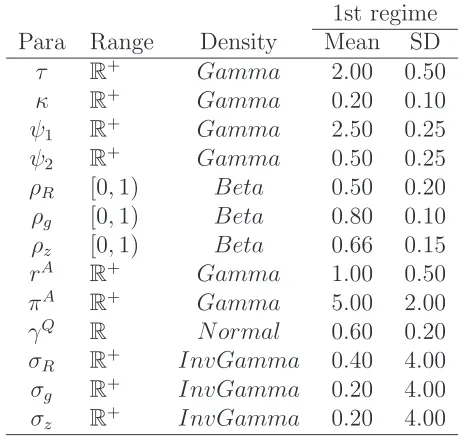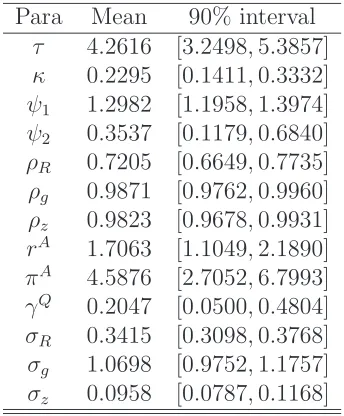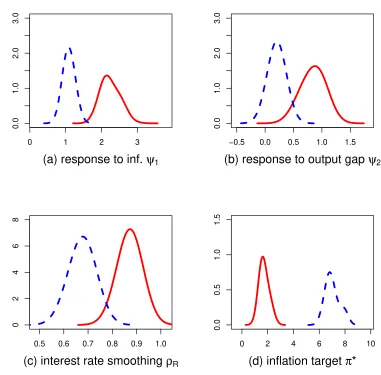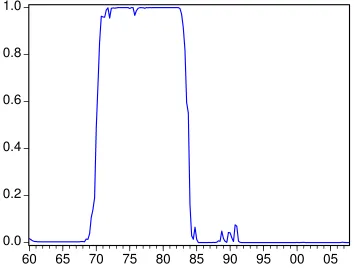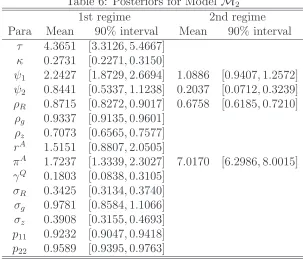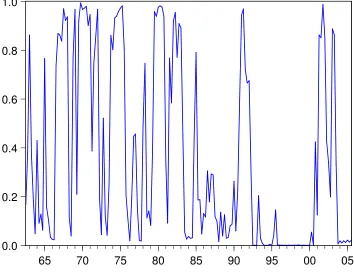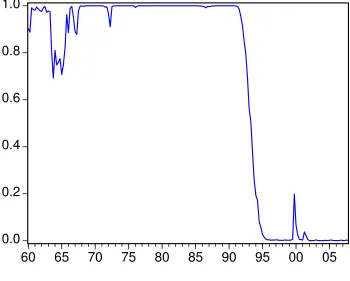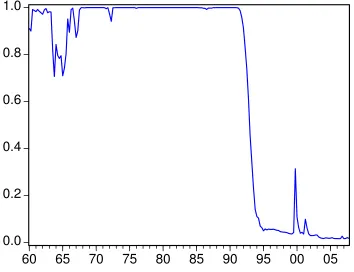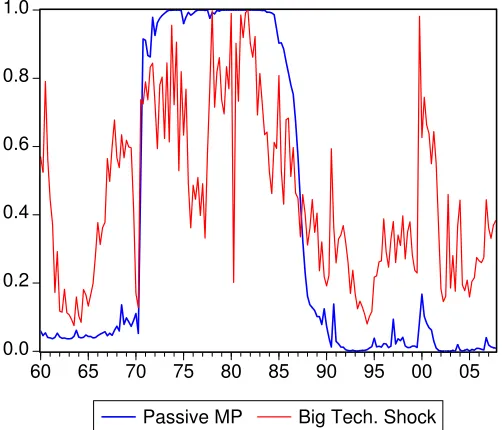Munich Personal RePEc Archive
Bayesian Analysis of DSGE Models with
Regime Switching
Eo, Yunjong
University of Sydney
August 2008
Online at
https://mpra.ub.uni-muenchen.de/70532/
Bayesian Analysis of DSGE Models with Regime
Switching
Yunjong Eo
∗School of Economics
University of Sydney
Abstract
I estimate DSGE models with recurring regime changes in monetary policy (inflation target and reaction coefficients), technology (growth rate and volatil-ity), and/or nominal price rigidities. In the models, agents are assumed to know deep parameter values but make probabilistic inference about prevailing and future regimes based on Bayes’ rule. I develop an estimation method that takes these probabilistic inferences into account when relating state variables to observed data. In an application to postwar U.S. data, I find stronger sup-port for regime switching in monetary policy than in technology or nominal rigidities. In addition, a model with regime switching policy that conforms to the long-run Taylor principle given in Davig and Leeper (2007) is preferred to a determinacy-indeterminacy model motivated by Lubik and Schorfheide (2004). These empirical results indicate that, even though a passive policy regime pro-duced more volatility in the economy from the early 1970s to the mid-1980s, the economy can be explained by determinacy over the entire postwar period, implying no role for sunspot shocks in explaining the changes in volatility.
JEL classification: C11, C32, C51, C52, E32, E52
Keywords: New Keynesian DSGE; Markov-switching; Monetary Policy; In-determinacy; Long-run Taylor Principle; Bayesian Analysis;
∗I thank James Bullard, Steven Fazzari, and James Morley for helpful discussions and comments
1
Introduction
The empirical literature (e.g., Stock and Watson (1996, 2002)) has demonstrated that
postwar U.S. macroeconomic data have experienced structural changes with
compli-cated patterns such as persistent increases and decreases in means and variances.
From a theoretical perspective, agents in the economy should, given these
struc-tural changes, have a different understanding about the economy over time and react
to the instability. In terms of the U.S. economy, less volatile GDP and inflation
since the mid-1980s are the two striking examples of structural changes. Economists
have been debating the causes of the “Great Moderation” and two popular
explana-tions are improved monetary policy1 and the “Good Luck” hypothesis.2 Meanwhile,
even if active monetary policy has stabilized the U.S. economy since the mid-1980s,
the source of highly volatile economy before the mid-1980s is not fully understood.
Lubik and Schorfheide (2004) have argued that passive monetary policy led to
inde-terminacy, implying that sunspot shocks were the cause of higher volatility in the
1970s. By contrast, Davig and Leeper (2007) suggest a theoretical alternative that
passive policy generated higher volatility by amplifying “fundamental” shocks under
determinacy in the long-run, rather than “sunspot” shocks under indeterminacy. This
amplification of fundamental shocks under determinacy occurs if the passive policy is
conducted only for short periods of time or the degree of the passive policy is close to
the boundary between the active and passive policies. Davig and Leeper refer to the
conditions that satisfy determinacy given periods of passive policy as the “long-run
Taylor principle.”
I estimate and compare New Keynesian DSGE models with regime changes in
order to examine the sources of high volatility of U.S. output and inflation in the
1970s and the so-called “Great Moderation” in the 1980s. I find stronger support for
1
For examples of good monetary policy argument, see Clarida, Gali, and Gertler (2000), Lubik and Schorfheide (2004), and Boivin and Giannoni (2006).
2
regime switching in monetary policy than in technology or nominal rigidities based
on model comparison using marginal likelihoods of models. Also, I find that the
long-run Taylor principle-type monetary policy regime switching model is preferred to the
determinacy-indeterminacy model. These empirical results mean that, even though a
passive policy regime produced more volatility in the economy from the early 1970s
to the mid-1980s, the long-run Taylor principle holds over the entire postwar period,
implying equilibrium determinacy and no role for sunspot shocks in explaining the
changes in volatility.
While motivated by the existing literature, my analysis is distinguished from the
conventional New Keynesian model studies in several ways.
First, I endogenously make inference about regime changes and the inferences take
into account agents’ probabilistic assessments of regimes. In particular, the response
to inflation and output gap in monetary policy, the growth rate and the variance of
technology shock, and the nominal rigidity parameter could be dependent on regimes
of the economy. I also consider both monetary policy change and stochastic volatility
together, but changes are treated as independent, allowing me to isolate the effects of
the “Good Luck” and monetary policy on the volatility decline after the early 1980s.
Second, the agents in the economy form expectations about key variables in the
next period by considering possible regime changes in each period. In particular,
transition probabilities are incorporated in model equations directly. This
specifica-tion is different from the convenspecifica-tional regime switching analysis such as Hamilton
(1989) and Kim and Nelson (1999b) in which the data generating process depends
only on the true underlying regimes, rather than probabilistic assessments of regimes,
implying that agents know current and past regimes and believe that the current
regime will last forever. Meanwhile, the possibility of a transition to other regimes
can affect the equilibrium under a given regime and the dynamics in the economy.
Davig and Leeper’s (2007) long-run Taylor principle expands the set of determinate
gen-eral regime switching models (e.g., technology, nominal rigidities as well as monetary
policy).
Third, building on the literature on Bayesian estimation of DSGE models, I
de-velop a method for estimating models with forward-looking regime switching along
the lines of the form proposed in Davig and Leeper (2007). They present the
long-run Taylor principle theoretically, but they do not examine it in an empirical setting.
In order to link observed data to unobservable regime-dependent state variables in
multiple regime equations, I integrate the regime-dependent state variables3 in each
period over the probability of each regime. The probability of the regime is calculated
and updated recursively based on Bayes’ rule every period.
Fourth, I “endogenously” estimate the timing of regime changes in a
determinacy-indeterminacy DSGE model that is motivated by Lubik and Schorfheide (2004). This
model specification is different from regime switching models discussed above in the
sense that the agents in this economy regard the current regime as a permanent
regime and do not allow for the possibility of regime changes in the future.
How-ever, the parameters for the model are unrestricted, so as to allow for the possibility
of indeterminacy. Comparing this determinacy-indeterminacy regime change model
with the long-run Taylor principle-type model allows me to determine whether the
higher volatilities of economic variables were induced by (i) sunspot shocks when the
economy is under indeterminacy or (ii) a passive monetary policy with the long-run
Taylor principle holding.
The rest of this paper proceeds as follows. Section 2 introduces forward-looking
rational expectations model with regime switching and compare it to conventional
regime switching model by using a simple univariate model. Section 3 describes a
standard New Keynesian DSGE model without regime switching. Section 4
intro-duces forward-looking rational expectations models with recurring regime changes
3
in the context of DSGE models and shows how to construct a state-space form for
these models. Section 5 discusses the endogenous identification of determinacy and
indeterminacy in the setting of regime switching analysis. Section 6 explains how to
make inferences about model parameters and the probability of regimes in a Bayesian
econometrics framework and summarizes empirical results. Section 7 concludes.
2
A Standard New Keynesian DSGE model
In this paper, I use a standard New Keynesian dynamic stochastic general equilibrium
(DSGE) model, which involves three main equations (an IS relationship, a Phillips
curve, and a monetary policy rule), three exogenous shock processes (a technology
shock, a preference shock, and a monetary policy shock), and log-linear
approxi-mations. These equations are derived in Woodford (2003) and An and Schorfheide
(2007) as follows.
ˆ
yt=Et[ˆyt+1] + ˆgt−Et[ˆgt+1]−
1
τ( ˆRt−Et[ˆπt+1]−Et[ˆzt+1]) (1)
ˆ
πt =βEt[ˆπt+1] +κ(ˆyt−gˆt) (2)
ˆ
Rt=ψ1πˆt+ψ2yˆt+et (3)
ˆ
zt =ρzzˆt−1+ǫzt (4)
ˆ
gt =ρgˆgt−1 +ǫgt (5)
ˆ
et=ρeˆet−1+ǫet (6)
Let ˆxt=ln(xt/x) denote the percentage deviation of a variable xt from their
steady-state x where xt = Xt/At is a detrended variable and At is aggregate productivity
growth rate γ and the exogenous shock zt:
lnAt =lnγ+lnAt−1+lnzt
where zt evolves according to univariate AR(1) process in (4).4 Equation (1) is the
intertemporal Euler equation and is derived from the households’ optimization
prob-lem whereτ−1
denotes the intertemporal substitution elasticity. Since the model does
not include the capital accumulation channel, consumption is proportional to output
and perturbed by the exogenous shockgtwhich follows the AR(1) process in (5). The
shock gt is interpreted broadly as a preference shock as well as a governmental
ex-penditure shock. The expectational Phillips curve in equation (2) is produced from a
continuum of monopolistically competitive firms’ profit maximization problem where
κ is a measure of nominal price stickiness due to quadratic adjustment costs and β
is the households’ discount factor. The central bank follows a Taylor-type rule by
adjusting the nominal interest rate in response to deviations of inflation and output
from their steady-state levels. The shock etis the unexpected deviation from the
pol-icy rule and follows the AR(1) process with error ǫet in (6). In addition, the central
bank is assumed to smooth the policy interest rate.
Moreover, the one period ahead expectation of exogenous shock depends on the
current value of the shock and its persistence:
Et[ˆgt+1] = Et[ρggˆt+ǫgt] = ρggˆt (7)
Et[ˆzt+1] = Et[ρzzˆt+ǫzt] =ρzzˆt. (8)
Substituting (7) and (8) into (1), the IS equation can be expressed in terms of the
current period variables. The rational expectations model system includes all the
equations which consist of endogenous variables (ˆxt,πˆt,Rˆt) and exogenous process
4
variables (ˆzt,gˆt,ˆet). Thus, the system can be rewritten as a matrix form as follows.
Γ0Xt=Γ1EtXt+1+Ψξt (9)
whereXt= [ˆyt,πˆt,Rˆt]′, and ξt= [ˆgt,zˆt,ˆet]′. A solution to equation (2) is a bounded
stochastic process ξt. Sims (2002) develops a solution algorithm and provides
condi-tions on the matrices Γ0, Γ1, Ψ, and Π under which there exists a unique solution
(determinacy), multiple solutions (indeterminacy), and no solution (explosive
pro-cess). The nature of equilibrium depends on generalized eigenvalues of matrices (Γ0,
Γ1).5
The matrices Γ0, Γ1, and Ψ contain the appropriate model parameters. The
nature of equilibrium depends on generalized eigenvalues of matrices (Γ0, Γ1)
The necessary and sufficient conditions for the existence there exists a unique
solution (determinacy), multiple solutions (indeterminacy), and no solution (explosive
process).
Then, I can easily solve this rational expectations model by using the method of
undetermined coefficients and get a reduced form as follows.
Xst,t=G(st)ξt
ǫt = [ǫgt, ǫzt, ǫet]′
ξt = Φξt−1+ǫt
The measurement equations allow for linking observables (the growth rate of per
capita output: ∆yt, the annualized inflation rate: πt, and the nominal interest rate:
5
For details, see Sims (2002) and Lubik and Schorfheide (2003, 2004). For the purely forward looking model, if|a|<1, the dynamics is under determinacy, and if|a| ≥1 it is under indeterminacy
Rt to unobservable state variables in the transition equation system. lnRGDPt INFt INTt
| {z }
Dt =
lnAt(+lny∗) + ˆyst,t πA+ 400ˆπ
st,t πA+rA+ 4γQ+ 400 ˆR
st,t
=
0(+lny∗
)
πA
πA+rA+ 4γQ
| {z }
δ +
1 0 0 1
0 4 0 0
0 0 4 0
| {z }
A ˆ
yst,t
ˆ
πst,t
ˆ
Rst,t lnAt
| {z }
[X′
st,t,lnAt]′
(10)
Xst,t
lnAt
=
G(st) 03
×1
01×3 1
| {z }
B(st)
ξt
lnAt
| {z }
αt
(11)
ξt
lnAt
| {z }
αt
=
03
×1
γQ
| {z }
µ
+
Φ3
×3 03×1
ρz 0 0 1
| {z }
F
ξt
−1
lnAt−1
| {z }
αt−1
+
ǫt
zt
| {z }
vt
(12)
where
vt∼ N (04×1, Q(st))
and
Q(st) =
I3
0 1 0
σ2
g,st 0 0
0 σ2
z,st 0
0 0 σ2
e,st
I3
0 1 0
′
.
of state variables, is augmented in the vector in order to detrend output.
In summary, the state space form is constructed as follows.
Measurement equations:
Dt=δ+H(st)αt
where H(st) = A×B(st)
Transition equations:
αt=µ+F αt−1 +vt, vt∼ N(04×1, Q(st))
MCMC sampling algorithm
Step 0. Initialize (s1:T, θ)
Step 1. Sample α1:T conditional on (D1:T,s1:T,θ)
Step 2. Sample s1:T conditional on (D1:T,θ,α1:T)
Step 3. Sample θ conditional on (D1:T, s1:T) Step 4. Repeat Steps 1-3
θ
3
New Keynesian DSGE models with Regime
Switch-ing
In the previous section, I briefly outlined the standard log-linearized equations for
New Keynesian DSGE models. However, this analysis is distinguished from
conven-tional New Keynesian studies. I take account of recurring regime changes in
mone-tary policy, technology, and nominal price rigidities. Agents in the economy consider
the possibility of the regime changes and know deep parameters but do not know
probabilistic manner by updating their information recursively. The possibility of a
transition to the other regimes can alter the stability conditions and the dynamics in
this economy. Davig and Leeper (2007) pointed out this possibility for monetary
pol-icy regimes corresponding to active and passive polpol-icy, and introduced a generalized
long-run Taylor principle which expands the set of determinate rational expectation
equilibrium. In this paper, I adopt their idea but extend it to general regime switching
models (e.g., technology, nominal rigidities as well as monetary policy). Throughout
this paper, two regimes are taken into account but it is straightforward to develop
models with more regimes.
3.1
Regime switching in policy
Davig and Leeper (2007) argue that the passive monetary policy might have induced
the higher volatility before 1980s, even with the long-run Taylor principle holding.
The idea is that the passive policy for some periods can still generate the determinacy
equilibrium if the passive policy is conducted only for short periods of time or the
degree of the passive policy is close to the boundary between the active and passive
policies. Based on this idea, I endogenously make inference about regime changes
from the viewpoint of agents who learn about regimes of the economy. In addition,
I allow for regime changes in the smoothing parameter (ρR) and the inflation target
(πA) as well as the reaction coefficients to inflation deviation from the inflation target
(ψ1) and output gap (ψ2). Under a regime i, the monetary policy rule is given by
ˆ
Rit = p1iρRiRˆ1t−1+p2iρRiRˆ2t−1+ (1−ρRi)[ψ1iπˆit+ψ2ixˆit] +ǫeit (13)
πA = πA
i , i=HorL (14)
and the inflation target is estimated in the measurement equation system as the mean
of the annualized inflation rate.6 The mean of inflation is also regime-dependent. I
6
assume that the central bank performs an active monetary policy with low inflation
target and a passive monetary policy with high inflation target.
3.2
Regime switching in technology
Stochastic volatility and the so-called “Great Moderation” have featured prominently
in the business cycle literature. This Markov-switching structure on volatility can
capture these volatility changes in a parsimonious and tractable way and represent
“Good Luck” story for the volatility reduction. I explicitly specify this feature by
introducing regime changes in technology.
ˆ
zit =p1iρzizˆ1t−1 +p2iρzizˆ2t−1+ǫzit,
ǫzit ∼ N(0, σzi2) σ
2
z1 < σz22. (15)
Meanwhile, Hamilton (1989) and Kim and Nelson (1999a) show that a simple
Markov-switching regime model can capture business cycle properties by matching
estimated probabilities of a recession regime to NBER recession dates. Thus, the
growth rate of technology shocks is associated with changes between boom and
re-cession in the present regime switching model. Then, given a regime i, the regime switching technology is directly related to the growth rate of output.
∆yit = γiQ+ ˆxit−p1ixˆ1t−1−p2ixˆ2t−1 + ˆzit
γiQ = γ Q H or γ
Q
L (16)
3.3
Regime switching in nominal rigidities
I also consider the possibility of time-varying price stickiness. The idea is that firms
have the incentive to reset prices more frequently when the economy faces bigger
shocks. Thus, the nominal rigidity parameter κ, which has a negative relationship with price stickiness, may increase in the variance of exogenous productivity shock:
ˆ
πit = βEt[ˆπt+1|st=i]−κi(ˆxt−ˆgt)
= β(pi1Et[ˆπ1t+1] +pi2Et[ˆπ2t+1]) +κi(ˆxit−ˆgit). (17)
The technology shock process for the changes in the volatility is the same as
equa-tion (15) but the growth rate of technology shock is constant.
3.4
Construction of state-space form
3.4.1 Transition equations
In forward-looking regime switching rational expectations models, state variables in
the state-space form are regime-dependent. Suppose the current regime is st = i
regime. Then, the monetary policy and the expectational Phillips curve equations
are modified to equations (13) and (17) respectively. In addition, the IS equation
consists of regime-dependent variables as follows.
ˆ
xit = Et[ˆxt+1|st=i] + ˆgit−Et[ˆgt+1|st=i]−
1
τi
( ˆRit−Et[ˆπt+1|st=i]−Et[ˆzt+1|st=i])
= pi1Et[ˆx1t+1] +pi2Et[ˆx2t+1] + ˆgit−pi1ρg1ˆgit−pi2ρg2gˆit
−1
τi
( ˆRit−pi1Et[ˆπ1t+1]−pi2Et[ˆπ2t+1]−pi1ρz1zˆit−pi2ρz2zˆit) (18)
In equation (18), the expectations of the exogenous shocks are calculated by
consid-ering the possibility of regime change from regimei to regime j = 1,2 as
Et[ˆgt+1|st=i] = pi1ρg1gˆit+pi2ρg2gˆit
Then, the transition equations are collected in a multivariate equations form. For the
case of two regimes, I need to consider two sets of state variables for the transition
equations in the state-space form.
Γ0 ˆ
x1t
ˆ
π1t
ˆ
R1t
Et−1[ˆx1t]
Et−1[ˆπ1t]
ˆ
g1t
ˆ
z1t
ˆ
x2t
ˆ
π2t
ˆ
R2t
Et−1[ˆx2t]
Et−1[ˆπ2t]
ˆ
g2t
ˆ
z2t
| {z }
ξt
= Γ1 ˆ
x1t−1
ˆ
π1t−1
ˆ
R1t−1 Et−2[ˆx1t−1] Et−2[ˆπ1t−1]
ˆ
g1t−1
ˆ
z1t−1
ˆ
x2t−1
ˆ
π2t−1
ˆ
R2t−1 Et−2[ˆx2t−1] Et−2[ˆπ2t−1]
ˆ
g2t−1
ˆ
z2t−1
| {z }
ξt−1
+Ψ
ǫR1t
ǫg1t
ǫz1t
ǫR2t
ǫg2t
ǫz2t
+ Π ηx 1t ηπ 1t ηx 2t ηπ 2t
| {z }
ǫt
After solving the rational expectations model, the transition equations system can be
rewritten as
ξ 1t
ξ2t
=G
ξ 1t−1
ξ2t−1
+W ǫ 1t ǫ2t where
ξit=
h
ˆ
xit,πˆit,Rˆit,Et−1[ˆxit],Et−1[ˆπit],gˆit,zˆit′
i′
3.4.2 Measurement equations
In order to construct a likelihood function, I utilize the Kalman filter given a
state-space form of measurement and transition equations. The measurement equations
link observables to unobservable state variables in the transition equation system.
However, in forward-looking regime switching models, the measurement equations
also contain the probability information of each regime. The measurement equations
are constructed by multiplying the probability of each regime up to time t −1 in-formation by the measurement equations of each regime so that regime dependent
variables are integrated over the probabilities of each regime.
∆yt
πt Rt = 2 X j=1
P[st =j|It−1]
γjQ+ (ˆxjt−p1jxˆ1t−1−p2jxˆ2t−1 + ˆzjt)
πA
j + 4ˆπjt
πA
j +rA+ 4γ Q
j + 4 ˆRjt
(19)
In equation (19), the probability of the current regime up to time t−1 information is calculated by multiplying Markov transition probability by probabilities of regimes
at timet up to timet−1 information.
P[st =j|It−1] =p1j×P[st−1 = 1|It−1] +p2j ×P[st−1 = 2|It−1] (20)
The probability of regimest=j at timetis updated recursively based on Bayes’ rule
with data yt = [y
1,· · · , yt]
′
.
P[st=j|It] = P[st=j|yt, It−1]
= f(yt, st=j|It−1)
f(yt|It−1)
= P2f(yt|st=j, It−1)P[st =j|It−1]
k=1f(yt|st=k, It−1)P[st=k|It−1]
3.5
Independent regime changes in technology and monetary
policy
I also consider monetary policy changes and stochastic volatility together. The two
are treated as independent, allowing us to isolate the effects of “Good Luck” and
monetary policy on volatility reduction after the early 1980s. Thus, this
specifica-tion examines whether it was monetary policy or so-called “Good Luck” that played
the key role in the “Great Moderation.” For this specification, I introduce two
in-dependent regime switching transitions. For example, monetary policy follows the
first switching system and stochastic volatility follows the second
Markov-switching system. I will take this approach in the next section in order to verify the
source of volatility reduction in the latter portion of the sample period. Let P1 and
P2denote two transition matrices respectively and assume that each regime switching
system consists of two regimes. Then, the number of all the possible regimes from
two independent structures is four (= 2×2).
P =P1⊗P2
and
st= 1 if (s1t = 1, s2t= 1)
st= 2 if (s1t = 1, s2t= 2)
st= 3 if (s1t = 2, s2t= 1)
st= 4 if (s1t = 2, s2t= 2)
(22)
where ⊗ denotes the Kronecker product. Then, as in (20)
Updating the probability of the current regime by observing data at time t is given by
P[sit =j|It]
= P[sit =j|yt, It−1]
= f(yt, sit =j|It−1)
f(yt|It−1)
= P2 f(yt|sit =j, It−1)P[sit =j|It−1]
l=1
P2
k=1f(yt|sit=k, s−it=l, It−1)P[sit =k, s−it=l|It−1]
=
P2
l=1f(yt|sit =j, s−it=l, It−1)P[sit=j, s−it =l|It−1]
P4
k=1f(yt|st =k, It−1)P[st=k|It−1]
.
where the subscript −i ins−it indicates any regime −i6=i
4
Endogenous Identification of Determinacy and
Indeterminacy Equilibria
Following the idea of Clarida, Gali, and Gertler (2000), Lubik and Schorfheide (2004)
show, using a DSGE model, that a change in monetary policy can explain higher
volatility in pre-Volcker years. They argue that the passive monetary policy led to
indeterminacy, implying that sunspot shocks played a role in generating the higher
volatility. They split postwar U.S. data into two subsamples “exogenously” based on
the appointment of Paul Volcker as Chairman of the Board of Governors of the
Fed-eral Reserve system and excluding Volcker disinflation period (1979:Q4 to 1982:Q3). I
estimate the determinacy-indeterminacy regime switching DSGE model and
“endoge-nously” identify two regimes. The agents in this economy regard the current regime
as a permanent regime and do not allow for the possibility of regime changes in the
future. Thus, technically I solve the rational expectations model for each regime
separately and estimate regime changes by adopting a conventional regime-switching
higher volatilities of economic variables are induced by (i) a passive monetary policy
with the long-run Taylor principle holding or (ii) sunspot shocks when the economy
is under indeterminacy. In this paper, Hamilton’s filter and Kim’s filter enable me
to estimate this model. For more details about Hamilton’s filter see Hamilton (1989)
and Hamilton (1994), and about Kim’s filter see Kim (1994) and Kim and Nelson
(1999b).
5
Bayesian Estimation
5.1
Methodology
I develop a method to estimate forward-looking regime switching models. Davig
and Leeper (2007) present the long-run Taylor principle theoretically, but they do
not examine it in an empirical setting. In addition, they take into account only the
transition equations. However, I append the model with measurement equations in
order to evaluate a likelihood function through Kalman filtering for the state-space
form as in (19). Econometricians observe one data set but transition equations and
unobservable regime dependent variables such as xit in (??) are based on multiple
regimes. Thus, I integrate state variables over the probabilities of each regime in
order to match them to the observables. The probability of the regime is calculated
and updated recursively based on Bayes’ rule every period as in (20) and (21). While
agents in the economy know deep parameter values, they do not know the current
regime and so they are learning about it. I, as an econometrician, estimate model
parameters and probabilities of regimes each period.
I estimate and compare various regime switching models with a likelihood-based
approach. by adopting the Metropolis-Hastings (MH) algorithm with randomized
multiple blocks. Chib and Greenberg (1995) suggest the use of fat-tailed proposal
to ensure that proposed values visit the tails of the posterior distributions and I
freedom of 15. In particular, Chib and Ramamurthy (2008) develop an approach that
randomly generates blocks and finds a proposal density for each block by adapting the
location and curvature and holding other blocks fixed at every iteration. Although
the random-walk MH proposal with a single block, most of likelihood-based DSGE
estimations have used, is faster and convenient to calculate marginal likelihoods,
the recent literature advocates the use of the randomized multiple blocks in DSGE
models due to following reasons. An and Schorfheide (2007) show that the single
block random-walk proposal often gets stuck at a local posterior mode. In such
a case, the performance and reliability of the MH algorithm are sensitive to the
starting point, making it important to find the global posterior mode accurately. In
addition, Sims, Waggoner, and Zha (2008) point out that it takes multiple weeks of
CPU time to find the posterior mode especially in large Markov-switching models and
propose the use of a blockwise optimization method. Chib and Ramamurthy’s (2008)
idea is similar to the blockwise optimization but it is more reliable in the sense that
this algorithm reoptimizes over iterations and the simulation does not hinge on the
starting point which is possibly a local mode. In particular, having adopted multiple
blocks, it is not known which parameters should be in the same block. In New
Keynesian DSGE models, all the parameters are highly-nonlinearly related by model
equations and their equilibrium conditions. Thus, the randomized block scheme is an
alternative approach.
This analysis is based on postwar U.S. quarterly data from 1960:Q1 to 2007:Q4.
The estimation of model parameters and probability of regimes can be affected by
initial values of state variables and regime probabilities. Thus, the initial values are
determined from pre-sample period from 1954:Q1 to 1959:Q4. I restrict parameter
space to induce determinacy equilibrium in the forward-looking regime switching
models, but the determinacy-indeterminacy regime switching model obviously allows
5.2
Model priors
[image:20.595.91.523.221.326.2]The models are characterized in Table 1 and priors are listed in Table 2. In the
Table 1: DSGE Models with Regime-Switching
Model Regime-Switching parameters
M0: No regime switching None M1: Growth rate of technology γQ
M2: Monetary policy ψ1,ψ2,πA, ρR
M3: Variance of tech. shock σz
M4: Price stickiness and variance of tech. κ, σz
M5: Monetary policy(1st); Variance of tech.(2nd) 1st: ψ1,ψ2, πA, ρR; 2nd: σz
regime switching models, I regard the first regime as ordinary (e.g., active monetary
policy, boom, or less volatile economy) and the second regime as unusual (e.g., passive
monetary policy, recession, or highly volatile economy). Model M0 is a benchmark
model without regime switching. Priors for the “no regime switching” model and the
first regime in the various regime switching models are similar to An and Schorfheide
(2007) except for some key parameters related to regime switching. Among regime
switching models, model M1 allows for regime switching for growth rate of
produc-tivity. Hamilton (1989) applied his Markov-switching model of univariate
autore-gressive regression to U.S. real GNP growth and found that the MLE estimate of
the growth rate under the recession regime is -0.36. Thus, the prior for the growth
rate under the recession regime is a Normal distribution with mean -0.2 and
stan-dard deviation 0.2 while the prior mean of growth rate under the usual regime is
0.6 with standard deviation 0.2. The regime change in monetary policy is
exam-ined in model M2. I choose priors for reaction coefficients to inflation and output
gap consistent with those of the previous literature such as Clarida, Gali, and Gertler
(2000) and Lubik and Schorfheide (2004). The prior of the inflation coefficient is a
Gamma distribution with mean 2.50 and standard deviation 0.25 under the active
policy regime, while 0.50 and 0.25 respectively under the passive policy regime. I
an autoregressive coefficient ρR is the same across regimes with a Beta distribution
with mean 0.5 and standard deviation 0.2 so that it is reasonably diffuse. ModelM3
represents the so-called “Good Luck” story or stochastic volatility. In this model,
the technology shock is the main source of fluctuations in the economy so that only
the variance of technology shock is allowed to change. I estimate standard deviations
for variances of shocks rather than variances directly and the standard deviation has
an Inverse Gamma distribution. Model M4 incorporates regime changes in nominal
rigidities in response to the size of exogenous productivity shock. Since the price
rigidity parameter κincreases in the volatility of technology shock, the prior mean is 0.2 under the ordinary regime and 0.4 under the high volatile regime. In model M5,
there are two independent regime switching systems in order to identify the source
of “Great Moderation,” as explained in the previous section. One regime switching
system is related to the stochastic technology shock and the other is related to the
monetary policy. I complete this section by explaining priors for the transition
prob-abilities. All the transition probabilities pii where i = 1,2 have a Beta distribution
with mean 0.9 and standard deviation 0.09. This prior is diffuse enough not to affect
making inferences about probabilities of regimes.
5.3
Empirical results
I compare various models with marginal likelihood calculations and report the nature
of regime switching in postwar U.S. economy. The marginal density calculations are
based on Chib and Ramamurthy (2008). Given model Ms, the marginal density
m(y|Ms) can be written as
m(y|Ms) =
π(θ, P)f(y|θ, P)
π(θ, P|y)
Then, for anyθ, basic marginal likelihood identity holds and the logarithm of marginal likelihood of modelMscan be estimated atθ
∗
Table 2: Priors for no regime-switching model 1st regime Para Range Density Mean SD
τ R+ Gamma 2.00 0.50
κ R+ Gamma 0.20 0.10
ψ1 R+ Gamma 2.50 0.25
ψ2 R+ Gamma 0.50 0.25
ρR [0,1) Beta 0.50 0.20
ρg [0,1) Beta 0.80 0.10
ρz [0,1) Beta 0.66 0.15
rA
R+ Gamma 1.00 0.50
πA
R+ Gamma 5.00 2.00
γQ R Normal 0.60 0.20
σR R+ InvGamma 0.40 4.00
σg R+ InvGamma 0.20 4.00
σz R+ InvGamma 0.20 4.00
Table 3: Priors for regime-switching model 1st regime 2nd regime Para Range Density Mean SD Mean SD
κ R+ Gamma 0.20 0.10 0.40 0.10
ψ1 R+ Gamma 2.50 0.25 0.50 0.25
ψ2 R+ Gamma 0.50 0.25 0.50 0.25
ρR [0,1) Beta 0.50 0.20 0.50 0.20
πA
R+ Gamma 5.00 2.00 7.00 2.00
γQ R Normal 0.60 0.20 - 0.20 0.20
σz R+ InvGamma 0.20 4.00 1.00 4.00
pii [0,1) Beta 0.90 0.09 0.90 0.09
[image:22.595.155.457.531.680.2]density,
lnmˆ(y|Ms) = lnf(y|θ
∗
,Ms) +lnπ(θ
∗
|Ms)−lnπˆ(θ
∗
|y,Ms).
The estimates of marginal likelihoods are reported in Table 4. Based on the marginal
likelihood calculations, the monetary policy regime switching model is selected. Thus,
I focus most of my discussion on the “no regime switching” model M0 and the
[image:23.595.106.509.335.442.2]monetary policy model M2.
Table 4: Model Comparison and Marginal Likelihood
Model Log-Marginal Likelihood M0: No regime switching -923.02
M1: Growth rate of technology -896.16 M2: Monetary policy -830.82 M3: Variance of tech. shock -870.64 M4: Price stickiness and variance of tech. -855.71 M5: Monetary policy(1st); Variance of tech.(2nd) -835.23
Table 5: Posteriors for no regime-switching model Para Mean 90% interval
τ 4.2616 [3.2498,5.3857]
κ 0.2295 [0.1411,0.3332]
ψ1 1.2982 [1.1958,1.3974]
ψ2 0.3537 [0.1179,0.6840]
ρR 0.7205 [0.6649,0.7735]
ρg 0.9871 [0.9762,0.9960]
ρz 0.9823 [0.9678,0.9931]
rA 1.7063 [1.1049,2.1890]
πA 4.5876 [2.7052,6.7993]
γQ 0.2047 [0.0500,0.4804]
σR 0.3415 [0.3098,0.3768]
σg 1.0698 [0.9752,1.1757]
σz 0.0958 [0.0787,0.1168]
I begin by looking at results from no regime switching model (M0). The posterior
[image:23.595.220.392.491.699.2]coeffi-cient in monetary policy from the posterior distribution is greater than one, at least
according to the 90% credible set. In the monetary policy regime switching model
(M2), under the active policy regime, the central bank increases the nominal interest
rate by 2.25 percent (posterior mean) in response to 1 percent inflation deviation
from the target while it adjusts 1.09 percent under the passive regime. These
coeffi-cient estimations are close to 2.19 and 0.89 respectively that Lubik and Schorfheide
(2004) attained in subsample analysis. Although the posterior mean of the
coeffi-cient under the passive regime from Lubik and Schorfheide’s (2004) estimation is
below one and my estimate of the posterior mean is greater than one, the 90%
credible set of the coefficient under the passive regime includes a lot of mass
be-low one. This fact is illustrated well in Figure 1 and reported in Table 6. Note that
in Lubik and Schorfheide (2004) the passive regime was driven by indeterminacy in
the pre-Volcker years. However, this regime switching analysis shows that even the
passive monetary policy induced a determinacy equilibrium in the long run due to
the possibility of the switching to active policy, although the passive policy could be
a source of high volatility.7 In this scenario, the postwar U.S. economy experienced
two regime switching points around early 1970s from active to passive policy and
around mid-1980s from passive to active policy as shown in Figure 2. In addition,
the target inflation was high with 7.02 comparing to 1.72 under the active regime. It
also reflects the “Great Inflation” of the 1970s. Although the transition matrix for the
regime switching is not restricted to generate persistent regimes a priori, agents’ belief
about regimes clearly looks like two structural breaks. In addition, the second regime
switching point is consistent with the estimate of a structural break in the form of
a volatility reduction in Kim and Nelson (1999a) and McConnell and Perez-Quiros
(2000). As for other parameters that are subject to regime switching, the reaction to
the output gap is more aggressive in the active policy regime (0.84 vs 0.20) and the
7
Figure 1: Posterior Distributions from Monetary Policy Regime Switching Model (M2)
0 1 2 3
0.0
1.0
2.0
3.0
(a) response to inf. ψ1
−0.5 0.0 0.5 1.0 1.5
0.0
1.0
2.0
3.0
(b) response to output gap ψ2
0.5 0.6 0.7 0.8 0.9 1.0
0
2
4
6
8
(c) interest rate smoothing ρR
0 2 4 6 8 10
0.0
0.5
1.0
1.5
(d) inflation target π*
Figure 2: Probability of Passive Monetary Policy Regime (M2)
(P[st = passive policy|It])
0.0
0.2
0.4
0.6
0.8
1.0
Table 6: Posteriors for Model M2
1st regime 2nd regime Para Mean 90% interval Mean 90% interval
τ 4.3651 [3.3126,5.4667]
κ 0.2731 [0.2271,0.3150]
ψ1 2.2427 [1.8729,2.6694] 1.0886 [0.9407,1.2572]
ψ2 0.8441 [0.5337,1.1238] 0.2037 [0.0712,0.3239]
ρR 0.8715 [0.8272,0.9017] 0.6758 [0.6185,0.7210]
ρg 0.9337 [0.9135,0.9601]
ρz 0.7073 [0.6565,0.7577]
rA 1.5151 [0.8807,2.0505]
πA 1.7237 [1.3339,2.3027] 7.0170 [6.2986,8.0015]
γQ 0.1803 [0.0838,0.3105]
σR 0.3425 [0.3134,0.3740]
σg 0.9781 [0.8584,1.1066]
σz 0.3908 [0.3155,0.4693]
p11 0.9232 [0.9047,0.9418]
p22 0.9589 [0.9395,0.9763]
nominal interest rate adjustment involves more smoothing in the active policy regime
(0.83 vs 0.68). This finding is consistent with the argument of Bullard and Mitra
(2007) that the monetary policy inertia helps induce determinacy equilibrium given
the degree of response to inflation discrepancy.
I also estimate the determinacy-indeterminacy model. In terms of timing, the
probability of the indeterminacy regime in postwar U.S economy has a similar
pat-tern to the probability of the passive regime from a forward-looking monetary policy
regime-switching model. The marginal likelihood calculation shows that the marginal
likelihood of the determinacy-indeterminacy model is -887.23 while the
forward-looking rational expectations model fits postwar U.S. data better with a marginal
likelihood of -830.82. From this analysis, I can conclude that the long-run Taylor
6
Conclusion
I estimate DSGE models with recurring regime changes in monetary policy (inflation
target and reaction coefficients), technology (growth rate and volatility), and/or
nom-inal price rigidities. In the models, agents are assumed to know deep parameter values
but make probabilistic inference about prevailing regimes based on Bayes’ rule and
form the one period ahead expectations by taking account of possibilities of regime
changes. Building on a literature on Bayesian estimation of DSGE models, I develop
a method for estimating models with forward-looking regime switching along the lines
of the form proposed in Davig and Leeper (2007). In an application to postwar U.S.
data, I find stronger support for regime switching in monetary policy than in
tech-nology or nominal rigidities. Under the active policy regime, the policy reaction to
deviations from the targets of inflation and output was more aggressive and the
nomi-nal interest rate adjustment is smoother. I also estimate a determinacy-indeterminacy
DSGE model and compare this specification to the Davig and Leeper-type monetary
policy DSGE model. A marginal likelihood based model selection procedure prefers
the monetary policy regime switching model. This empirical finding implies that
even though a passive policy regime produced more volatility in the economy from
the early 1970s to the mid-1980s, the long-run Taylor principle appears to hold in
the entire postwar period, implying equilibrium determinacy and there is no role for
References
Ahmed, S., A. Levin, and B. A. Wilson (2004): “Recent U.S. Macroeconomic Stability: Good Policies, Good Practices, or Good Luck?,” The Review of Eco-nomics and Statistics, 86(3), 824–832.
An, S., andF. Schorfheide(2007): “Bayesian Analysis of DSGE Models,” Econo-metric Reviews, 26(2-4), 113–172.
Boivin, J., and M. P. Giannoni (2006): “Has Monetary Policy Become More Effective?,”The Review of Economics and Statistics, 88(3), 445–462.
Bullard, J., and K. Mitra (2007): “Determinacy, Learnability, and Monetary Policy Inertia,”Journal of Money, Credit and Banking, 39(5), 1177–1212.
Chib, S., and E. Greenberg (1995): “Understanding the Metropolis-Hastings Algorithm,” The American Statistician, 49(4), 327–335.
Chib, S., and S. Ramamurthy(2008): “MCMC Methods for Bayesian Estimation of DSGE Models,” Working Paper.
Clarida, R., J. Gali, and M. Gertler (2000): “Monetary Policy Rules And Macroeconomic Stability: Evidence And Some Theory,” The Quarterly Journal of Economics, 115(1), 147–180.
Davig, T., and E. M. Leeper(2007): “Generalizing the Taylor Principle,” Amer-ican Economic Review, 97(3), 607–635.
Hamilton, J. D. (1989): “A New Approach to the Economic Analysis of Nonsta-tionary Time Series and the Business Cycle,” Econometrica, 57(2), 357–84.
(1994): Time Series Analysis. Princeton University Press.
Justiniano, A., and G. E. Primiceri (2008): “The Time-Varying Volatility of Macroeconomic Fluctuations,”The American Economic Review, 98(3), 604–641.
Kim, C.-J. (1994): “Dynamic linear models with Markov-switching,” Journal of Econometrics, 60(1-2), 1–22.
(1999b): State-Space Models with Regime Switching: Classical and Gibbs-Sampling Approaches with Applications. The MIT Press.
Lubik, T. A., and F. Schorfheide (2003): “Computing Sunspot Equilibria in Linear Rational Expectations Models,” Journal of Economic Dynamics and Con-trol, 28(2), 273–285.
(2004): “Testing for Indeterminacy: An Application to U.S. Monetary Pol-icy,” American Economic Review, 94(1), 190–217.
McConnell, M. M., and G. Perez-Quiros (2000): “Output Fluctuations in the United States: What Has Changed since the Early 1980’s?,” American Economic Review, 90(5), 1464–1476.
Schorfheide, F. (2005): “Learning and Monetary Policy Shifts,” Review of Eco-nomic Dynamics, 8(2), 392–419.
Sims, C. A.(2002): “Solving Linear Rational Expectations Models,” Computational Economics, 20(1-2), 1–20.
Sims, C. A., D. F. Waggoner, and T. Zha (2008): “Methods for inference in large multiple-equation Markov-switching models,” .
Stock, J. H., and M. W. Watson (1996): “Evidence on Structural Instability in Macroeconomic Time Series Relations,”Journal of Business & Economic Statistics, 14(1), 11–30.
(2002): “Has the Business Cycle Changed, and Why?,” NBER Macroeco-nomics Annual, 17, 159–218.
Appendix
Figure 3: Probability of Low Growth Rate Regime (M1)
0.0 0.2 0.4 0.6 0.8 1.0
65 70 75 80 85 90 95 00 05
Figure 4: Probability of Large Exogenous Shock Regime (M3)
0.0
0.2
0.4
0.6
0.8
1.0
60
65
70
75
80
85
90
95
00
05
Figure 5: Probability of Large Exogenous Shock with Less Sticky Price Regime (M4)
0.0
0.2
0.4
0.6
0.8
1.0
60
65
70
75
80
85
90
95
00
05
Figure 6: Probabilities of Passive Monetary Policy Regime and Large Exogenous Shock Regime (M5)
0.0 0.2 0.4 0.6 0.8 1.0
60 65 70 75 80 85 90 95 00 05
Passive MP Big Tech. Shock
(a)P[st= Passive Monetary Policy|It] : Blue line
Table 7: Posteriors for Model M1
1st regime 2nd regime Para Mean 90% interval Mean 90% interval
τ 4.8187 [3.5287,6.4544]
κ 0.2834 [0.1788,0.4246]
ψ1 1.4088 [1.1262,1.8839]
ψ2 1.3359 [0.5957,2.3099]
ρR 0.7408 [0.6612,0.8309]
ρg 0.9760 [0.9550,0.9889]
ρz 0.7115 [0.5538,0.8273]
rA 1.1799 [0.3895,2.0672]
πA 3.9586 [1.8065,6.3989]
γQ 0.2485 [0.0602,0.4706] -0.1554 [−0.5596,0.1945]
σR 0.3355 [0.2888,0.3926]
σg 0.8383 [0.6377,1.2158]
σz 0.4162 [0.2623,0.6075]
p11 0.9771 [0.9007,0.9988]
Table 8: Posteriors for Model M3
1st regime 2nd regime Para Mean 90% interval Mean 90% interval
τ 4.3690 [3.2896,5.5264]
κ 0.3329 [0.2377,0.4829]
ψ1 1.3292 [1.0285,1.8445]
ψ2 0.8540 [0.2059,1.6429]
ρR 0.7685 [0.6908,0.8288]
ρg 0.9629 [0.9387,0.9837]
ρz 0.5528 [0.3667,0.6963]
rA 1.0613 [0.3524,1.7039]
πA 2.0511 [1.5754,2.4774]
γQ 0.1697 [0.0632,0.2734]
σR 0.3537 [0.3012,0.4125]
σg 0.7650 [0.6285,0.9569]
σz 0.1818 [0.1136,0.2825] 0.7092 [0.5221,0.8820]
p11 0.9897 [0.9777,0.9982]
Table 9: Posteriors for Model M4
1st regime 2nd regime Para Mean 90% interval Mean 90% interval
τ 4.2980 [3.3131,5.3196]
κ 0.2128 [0.1411,0.3039] 0.2950 [0.2160,0.4449]
ψ1 1.2886 [1.0506,1.5713]
ψ2 0.7562 [0.3721,1.2294]
ρR 0.7491 [0.6825,0.8017]
ρg 0.9749 [0.9536,0.9889]
ρz 0.5266 [0.3486,0.6847]
rA 1.1281 [0.4433,1.6643]
πA 2.0316 [1.7372,2.4613]
γQ 0.1490 [0.0438,0.2713]
σR 0.3631 [0.3134,0.4184]
σg 0.7721 [0.5737,0.9198]
σz 0.2133 [0.1151,0.3636] 0.7085 [0.5218,0.9092]
p11 0.9879 [0.9754,0.9979]
Table 10: Posteriors for Model M5
1st regime 2nd regime Para Mean 90% interval Mean 90% interval
τ 4.8929 [3.3554,6.7933]
κ 0.2632 [0.1781,0.3665]
ψ1 2.6329 [1.9647,3.2367] 0.8905 [0.8012,0.9791]
ψ2 1.2318 [0.4302,2.1938] 1.9685 [0.9157,3.0793]
ρR 0.9084 [0.8591,0.9499] 0.5006 [0.3406,0.7062]
ρg 0.9700 [0.9367,0.9897]
ρz 0.5297 [0.2847,0.7639]
rA 1.7654 [0.8646,2.6793]
πA 2.3075 [1.2003,3.1614] 6.2472 [3.4939,9.7099]
γQ 0.2354 [0.0315,0.4456]
σR 0.2495 [0.1408,0.3903]
σg 1.1079 [0.8945,1.3847]
σz 0.2451 [0.0185,0.5884] 1.2624 [0.6318,1.9460]
p11 0.8722 [0.8301,0.9494] 0.6281 [0.4646,0.7240]

